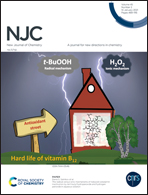The synthesis and antiproliferative activity of new N-allyl quinoxalinecarboxamides and their O-regioisomers
Abstract
We have designed a series of quinoxalinepeptidomimetic derivatives based on our previously reported scaffold in an attempt to find a promising lead compound. Quinoxalinepeptidomimetic derivatives, N-alkyl-3-(4-allyl-3-oxo-3,4-dihydro-quinoxalin-2-yl)propanamides, methyl 2-[3-(4-allyl-3-oxo-3,4-dihydro-quinoxalin-2-yl)propanamido] alkanoates, and their O-regioisomers, were prepared via the competing alkylation reaction of the ambient nucleophile, methyl 3-(3-oxo-3,4-dihydroquinoxalin-2-yl)propanoate, with allyl bromide to afford the corresponding O- and N-allyl quinoxaline ester derivatives. The esters gave the desired products through reactions with amines and amino acid esters via the azide coupling method. We have examined the antiproliferative activities of the 34 different synthesized compounds using human HCT-116 and HEH-293 cell lines. Out of 34 screened derivatives, 22 active compounds exhibited inhibitory action against the HCT-116 cells, with IC50 values ranging from 0.11 mg ml−1 to 0.78 mg ml−1. We also examined the impact of these active compounds on cancer cell nuclei and caspase 3 activity; we found that the active compounds also increased the caspase 3 activity, which led to the programmed cell death of cancer cells. We also examined the impact of 34 compounds on normal and non-cancerous cells (HE-293) and we found that these active compounds did not have any cytotoxic effects on normal cells.



 Please wait while we load your content...
Please wait while we load your content...